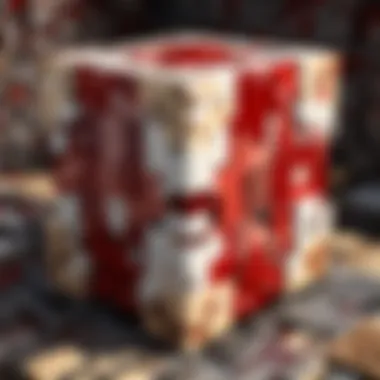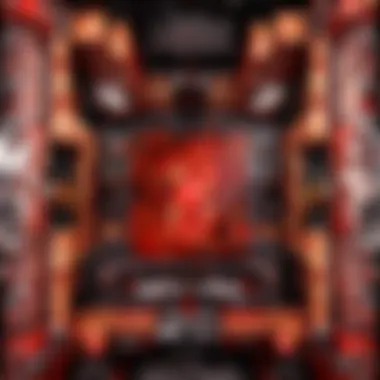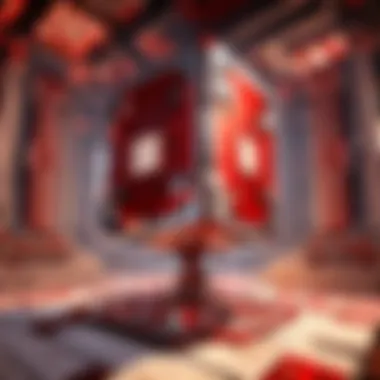Exploring Redstone Mechanics in Minecraft


Intro
Redstone, a cornerstone of engineering within Minecraft, functions much like electrical wiring in the real world. Its potential crafting and automation capabilities can transform your gameplay, offering a range of experiences from basic light switches to complex machines that can perform tasks automatically. Exploring the depth of this material not only enhances your creations but also unlocks a new level of creativity in the blocky universe.
With each block of redstone, you embark on a journey into a fascinating realm where logic reigns supreme and imagination knows no bounds. Understanding its basic mechanics serves as the first stepping stone. But, as you’ll discover throughout this piece, proficiency in redstone can dramatically change how you play the game, enabling players to devise intricately wired contraptions and machinery that bring dream projects to life.
We’re diving deep into redstone with this exploration, aiming to illuminate various strategies and the tremendous creative potential it offers. In the sections that follow, we will traverse through the fundamental concepts, unravel advanced techniques, and examine examples from the community that showcase what’s possible.
Minecraft Game Guides
Creating things in Minecraft can be a multifaceted experience. While redstone mechanics take center stage, it’s crucial to have an understanding of overall game mechanics to maximize the utility of redstone. Let's examine some building techniques that intertwine with redstone functionality and how character creation plays into larger creations.
Redstone Mechanics Explained
Redstone operates on a simple principle: it can transmit power from one block to another. Power can be activated by a variety of inputs, such as switches, buttons, and pressure plates. Here’s a primer on how redstone works:
- Redstone Dust: The basic component that carries redstone current.
- Power Sources: Items like levers or buttons that initiate the redstone circuit.
- Redstone Components: Includes repeaters that extend signals and comparators that can alter the signal based on certain parameters.
Understanding what these components do and how they interact is vital. For instance, does a button create a short pulse? How do repeaters affect timing? Taking the time to grasp these elements can seem daunting, but it's essential to advancing in redstone.
Crafting Recipes Encyclopedia
To effectively harness redstone, one must also be familiar with the crafting recipes that form its components. Here are a few key recipes:
- Redstone Dust: Crafted from redstone ore.
- Repeater: Requires 3 stones, 2 redstone dusts, and 1 torch.
- Comparator: Made with 3 stones, 3 redstone dusts, and 1 nether quartz.
"The more you understand redstone mechanics, the better you can strategize your use of this powerful toolset."
Grasping these recipes and knowing where to find the materials can save you considerable time when building your next contraption.
In the upcoming sections, we'll dive further into each component, exploring newbie mistakes to avoid, common traps people fall into, and detailed examples of functioning contraptions that use redstone to its fullest potential.
Understanding Redstone Mechanics
Understanding Redstone mechanics is akin to learning the alphabet of creativity within Minecraft. It lays the foundation for all players, from novices to those seasoned in their blocky adventures. Redstone, often compared to electrical wiring in the real world, serves as a means for players to create extensive contraptions, intricate machines, or even large-scale automation. Grasping the fundamental principles of Redstone empowers players not only to enhance their gameplay but also to express their ingenuity in designing complex systems.
Redstone is not just a tool; it’s a gateway to limitless possibilities in crafting interactive experiences within Minecraft.
As players delve into Redstone, they uncover various components and mechanisms that function similarly to circuitry. With this knowledge, a player can manipulate the game environment to respond dynamically. For example, a simple flick of a lever could activate an entire series of pistons, leading to hidden doors or traps. Understanding this complexity opens up an array of choices that can significantly impact gameplay.
Moreover, Redstone mechanics encourage problem-solving and logical thinking. Each contraption requires players to think critically about how each element interacts within a circuit. This not only heightens the enjoyment factor but also cultivates skills useful beyond the game itself. By engaging with Redstone, players learn to approach challenges with a mindset geared towards innovation and exploration.
In summary, Redstone mechanics are not merely technical specifications; they are the very essence of creativity and strategy in Minecraft. This section paves the way for deeper insights into what Redstone is, how it functions, and its basic properties. As we journey further into this exploration of Redstone, the importance of understanding its mechanics becomes crystal clear.
The Components of Redstone Technology
In the realm of Minecraft, Redstone serves as the backbone of ingenuity and mechanical marvels. The components of Redstone technology are not merely parts; they are the building blocks that enable players to create intricate contraptions and automate tasks. This section rounds up the various elements that constitute Redstone technology, shedding light on their individual roles and collective significance in enhancing the Minecraft experience.
Redstone Dust
Redstone dust is perhaps the most fundamental element in the Redstone ecosystem. You might think of it as the conductive wire that carries power and signals from one point to another. When laid down on the ground, it creates circuits that can transmit current from various components and serve as the foundation for any Redstone-based creation.
Key Features:
- Line of Transmission: Redstone dust can transmit power over a short distance and can be stacked to increase its reach.
- Connections: Players can connect it to various components, allowing for a seamless flow of signals.
While it may seem simple, the versatility of Redstone dust cannot be overstated. Its ability to integrate with other components means that players can design a broad spectrum of devices, from simple lights to complex machines.
Redstone Components
This segment encapsulates various specific items crucial in Redstone technology, each serving distinct functions and having unique characteristics. Understanding these components is vital for any player aiming to delve deeper into Redstone mechanics.
Redstone Torches
Redstone torches act as a power source and can function as an on/off switch in the Redstone world. When placed, a Redstone torch emits a continuous power signal, which can be useful for creating other devices.
Key Traits:


- Inverted Logic: When powered, a Redstone torch turns off, and when unpowered, it turns on. This characteristic makes it a favorite for various designs, especially those requiring secondary reactions.
In this article, we highlight its usefulness in creating a variety of Redstone contraptions that rely on this inverted behavior. However, it can suffer from power bleed if not managed properly, potentially leading to circuit faults.
Redstone Repeaters
Redstone repeaters serve a critical role by amplifying the power of Redstone signals. This amplification is essential for circuits that stretch over long distances, where signal strength can dissipate significantly.
Performance Features:
- Delay Mechanism: Repeaters can introduce delays, which are useful in creating intricate timing devices.
For those designing complex Redstone systems, repeaters are indispensable. The trade-off to keep in mind is that they only can extend the signal but not indefinitely; hence, their placement must be strategic.
Redstone Comparators
Comparators are the unsung heroes of Redstone devices, bringing a level of intelligence to circuits. They can compare signal strengths and serve several specialized functions, such as differentiating between inputs.
Unique Attributes:
- Signal Comparison: Comparators can process inputs from two sources, directing power based on the greater strength.
Their ability to perform nuanced tasks makes comparators popular among advanced users looking to implement more sophisticated designs.
Buttons and Levers
Buttons and levers are the most straightforward manual input devices players can use to control Redstone systems. A button provides a quick signal, while a lever can toggle a state on or off.
Significance:
- User Interaction: These components allow players to engage with their Redstone creations directly, making them essential for any circuit.
Though simple, their direct involvement in the user's cause leads to beneficial outcomes in various redstone projects, from opening doors to starting automated farms.
Pressure Plates
Amounting to another input mechanism, pressure plates activate when an entity is on top of them. This can be exceptionally useful for automating doors, traps, or even signaling mechanisms.
Key Considerations:
- Sensitivity: Pressure plates can activate with players, mobs, and even projectiles, increasing their utility in different contexts.
Yet, it's important to be mindful that their behavior can create unintended activations, depending on placement and context.
Power Sources
Power sources are vital in any Redstone circuit, dictating how signals flow through a given design. A thorough understanding of how to harness these power sources can elevate a player’s control over their creations.
Block Update Power
Block update power refers to the influence that an update to a neighboring block can have on adjacent Redstone components. This mechanic allows for complex chain reactions if used wisely.
Distinct Characteristic:
- Indirect Triggering: Changes in block states can cause neighboring Redstone devices to activate without direct connections.
This unique feature can enhance creative designs but may require careful planning to avoid unintended consequences.
Direct Powering
Direct powering occurs when Redstone components receive power directly from a block. This directly influences how designs operate since it can create immediate effects without intermediate steps.
Critical Aspect:
- Efficiency: Directly powered components are activated instantly, improving reaction times in complex mechanisms.
However, relying solely on direct powering may limit design complexity, so integrating diverse powering methods is often favorable for intricate Redstone devices.
Applications and Uses of Redstone


Redstone is more than just a resource in Minecraft; it is a gateway to unleashing creative potential and transforming gameplay. The applications and uses of redstone can make the difference between a simple home and a fully automated fortress that stands testament to a player's engineering prowess. Understanding these applications allows players to harness the true power of redstone, enhancing both the fun and functionality of their builds.
Basic Redstone Circuits
Starting off with the building blocks, basic redstone circuits form the foundation of many more complex contraptions. These circuits can be as straightforward as a lamp that lights up when activated or as intricate as multiple components working in sync.
For example, connecting redstone dust to a switch can light up a redstone lamp, showcasing how even the simplest configurations can yield fantastic results. Players should note the importance of understanding the layout; a basic circuit can include elements such as:
- Redstone Dust: The primary wiring component that transfers signals between parts.
- Levers: Simple on/off switches that initiate signals.
- Redstone Lamps: Provide a tangible result to a completed circuit.
Learning to arrange these basic components efficiently allows players to explore more complex implementations as they become comfortable with redstone's mechanics.
Advanced Circuitry and Logic Gates
Once comfortable with basic circuits, players can transition into advanced circuitry. Logic gates, which are vital for building more intricate redstone devices, serve as the core of these advancements. They help in determining how redstone signals interact and can enable features like:
- AND Gates (requiring two signals to activate).
- OR Gates (activating if at least one signal is present).
- NOT Gates (inverting the input signal).
By mastering these gates, players can create systems that decide outcomes based on multiple conditions, bringing complexity and depth to their creations. An example would be a locked door that only opens when both a lever and a button are pressed, enforcing a layer of security on their builds.
Redstone in Automation
Automation is one of the most significant benefits of redstone, turning mundane tasks into effortless actions. With a variety of components at their disposal, players can create contraptions that manage repetitive tasks without continual player involvement.
For example, farms can be automated using redstone to manage water flow or collect resources when certain conditions are met:
- Observer Blocks: Detect changes in the environment (like crop growth).
- Pistons: Use to push or pull blocks, creating a system that harvests crops automatically.
- Hoppers: Facilitate item collection, reducing the need for manual gathering.
This level of automation can vastly improve resource gathering efficiency, allowing players to focus on creative aspects rather than repetitive work.
Mining and Resource Gathering
Redstone also plays a crucial role in mining and resource gathering. To navigate the expansive world of Minecraft, players often seek tools and techniques that streamline their efforts. Utilizing redstone in this context can lead to:
- Redstone-activated TNT traps: Clear out large mine shafts quickly.
- Automated mining machines: Use pistons and minecart systems to gather ore tirelessly.
These methods can conserve time and energy, enabling players to harness more resources for their builds or other pursuits.
Creative Builds Using Redstone
Finally, the creative possibilities with redstone are boundless. From roller coasters that defy gravity to elaborate traps that outsmart unsuspecting friends, redstone provides the means to make unique creations. Players have built everything from fireworks displays to fully functional calculators, showcasing the vast range of what’s possible.
The fusion of creativity with technical knowledge can lead to astounding results. Players should not hesitate to experiment with various combinations of redstone components and mechanics, as this is where true innovation emerges.
Adventures in redstone are limited only by imagination, and crafting innovative machines or even intricate villages can enrich the Minecraft experience.
Mastering redstone not only enhances gameplay but also fosters creativity and problem-solving skills, making players better builders in their journey through Minecraft.
Common Redstone Contraptions
The realm of common redstone contraptions serves as a gateway for Minecraft players to explore the creative applications of redstone technology. This section aims to equip players with practical knowledge and inspire ingenuity in their builds. Understanding these contraptions can significantly enhance the gameplay experience by enabling automation and clever design strategies. Now, let's delve into some of the staple contraptions that players can master and utilize effectively in their Minecraft worlds.
Simple Traps
Simple traps are a clever application of redstone that can catch players or mobs off-guard. They serve both defensive and offensive purposes, allowing players to protect their territory or surprise unwary intruders. A basic trap can be as straightforward as a pitfall lined with tripwires and dispensers that shoot arrows. Here’s how it typically works:
- Tripwire setup: Placing a tripwire connected to dispensers filled with arrows can create an unexpected barrage.
- Hidden pits: Building a hidden pitfall can lure players into a trap, leading to a quick demise.
- Mob detectors: Use simple traps to automate mob farming. For example, utilizing a water flow trap that channels mobs into a kill zone.
These traps are not just about outsmarting foes; they can also add an element of surprise and excitement to gameplay.
Doors and Hidden Entrances
Doors and hidden entrances represent another significant area of redstone contraptions. These devices can make a player’s base feel more secure and secretive. Using redstone mechanisms, you can create classic hidden doors triggered by levers or pressure plates. Here are a few ideas:
- Piston doors: Use sticky pistons to create sliding doors that conceal entranceways. Activate them with a lever, button, or even a secret switch.
- Painting disguise: A simple painting can hide an entrance, and with a pressure plate behind it, you can easily enter or exit while keeping the door concealed.
- Redstone logic: Incorporating logic gates can allow for more complex entrance systems. For instance, a door that opens only when a certain sequence of levers has been engaged can add a puzzle element.
Using redstone in this way can turn a mundane entrance into a focal point of ingenuity and design.


Pistons and Their Uses
Pistons are at the heart of many creative redstone contraptions. These blocks can move other blocks when powered, allowing for a range of applications. Here are several key uses for pistons in redstone projects:
- Block movement: Moving blocks can create hidden rooms, escape routes, or trapdoors.
- Controlling water flow: Pistons can help regulate rivers or lakes, producing environments useful for farming or fishing.
- Furniture designs: With some creativity, pistons can form dynamic furniture, adding movement to your builds.
Pistons are versatile, and once you get the hang of how they interact with other redstone components, the sky's the limit for their creativity.
Automated Farms
Automated farms are among the most impressive redstone contraptions to consider in gameplay. They not only streamline resource gathering but also allow for sustainable farming efforts without constant player input. Here’s how you can set up an automated farm:
- Water canals: Use redstone mechanisms to activate water flows that can irrigate your crops automatically.
- Harvesting systems: Establish a collection of pistons and observers to clear fully grown crops and collect the harvested items automatically.
- Timing mechanisms: Utilize redstone clocks to create repeating signals that manage the irrigation and harvest cycles, ensuring maximum productivity.
Pursuing automated farming can free up a lot of time, allowing players to focus on other adventures in the vast world of Minecraft.
Automated farms not only enhance resource gathering but also reflect the level of ingenuity a player possesses in redstone technology.
In summary, the common redstone contraptions serve as a fundamental building block for the vast array of possibilities that Minecraft offers. Mastering them opens doors to creativity and strategic gameplay, making your experience in this virtual block-building world ever more engaging.
Common Pitfalls and Troubleshooting
Redstone is an immense and intricate part of Minecraft, acting as the backbone of many contraptions and creations. However, it comes with its fair share of pitfalls that can lead to frustration for players, especially those less familiar with its mechanics. Recognizing and understanding these common issues can significantly enhance your gameplay experience. In this section, we will review elements such as signal strength, diagnosing circuit failures, and clearing up misconceptions that often trip players up.
Understanding Signal Strength
Redstone operates on a system of signal strength, which can often be a point of confusion. The strength of a redstone signal decreases the farther it travels from its source. Think of it like a voice: speak softly to someone across a large room, and they might not hear you as well. Signals are measured on a scale from 0 to 15. A direct connection to a power source can produce a signal strength of 15, but if you use redstone dust, the power dissipates quickly beyond that. Here are some key points to understand:
- Redstone Dust: Each block of redstone dust only transmits a signal for 15 blocks away, and every block it travels reduces the signal by 1.
- Block Interference: If a signal goes through blocks, it can lose strength, complicating your designs.
- Repeater Usage: To get past those limits, you can use repeaters which can boost the signal back to 15.
By keeping an eye on your setup’s signal strength, you can avoid many circuit issues before they begin.
Diagnosing Circuit Failures
So, you built a marvelous contraption but nothing seems to work? Circuit failures can often feel like a daunting maze. The key is to approach the problem methodically:
- Check Power Sources: Ensure your power source is functioning correctly. Sometimes, it might just be a matter of connecting the right blocks.
- Trace the Connections: Follow the redstone wire from the source to your end goal, checking for breaks or dead ends.
- Test Individual Components: If a component seems faulty, test it in isolation. For example, if you’re using repeaters, check them one by one to see if they function as expected.
- Redstone Logic: Make sure that there is no conflicting logic in your design. For example, a redstone torch powered by a block that was also powered can create a loop that causes a failure.
Often, the simplest solutions can be the hardest to see in the heat of the moment.
Common Misconceptions
Many misconceptions hover around the topic of redstone technology. Addressing these can help players design more efficiently and with less frustration:
- “Redstone is too complicated to use.” This sentiment is common but not true. While it does have a learning curve, starting with simple projects can often yield satisfying results.
- “Repeater placements don’t matter.” Actually, repeater orientation can affect signal direction and timing, so make sure to understand how they work in context with your circuit.
- “I can power anything with redstone.” Not all blocks respond to redstone signals, so knowing which blocks can be powered is crucial.
Understanding these misconceptions can prepare you for the inevitable learning curve every redstone engineer faces.
“Knowledge is the key that can unlock the true potential hidden in the redstone blocks.”
By being aware of these common pitfalls and troubleshooting strategies, you can ensure that your experience with redstone is not only educational but also enjoyable. Whether you are getting into basic circuits or those keen on advanced contraptions, clarity is vital in this fascinating realm of Minecraft.
Future of Redstone in Minecraft
As the game evolves, the future of redstone in Minecraft looks increasingly promising. This essential element of the game serves as a backbone for players’ ingenuity, and its development ensures that the creative possibilities remain vast. The importance of exploring the future of redstone lies not just in its potential mechanics, but also in how it influences gameplay and community engagement. Players eagerly anticipate updates that introduce new redstone mechanics or enhance existing ones. These changes can provide fresh avenues for building, engineering, and automation within the game.
Updates and Changes
Over the years, Mojang has regularly rolled out updates that tweak redstone functionality. Each update opens a new chapter in the possibilities afforded by this versatile resource. For instance, the introduction of redstone lamps in Minecraft 1.5 brought light into the realm of redstone mechanisms, allowing players to create intricate lighting systems that respond to various triggers. As the community grows and feedback is taken into account, new elements continually emerge.
One significant aspect of future updates is the ongoing balancing act between complexity and accessibility. Mojang often aims to enhance redstone features without overwhelming novice players. Upcoming changes may focus on simplifying certain mechanisms while still providing depth for advanced players.
Moreover, updates like the integration of new blocks can change how redstone operates altogether. Imagine a future where a new block type interacts differently with redstone signals or offers unique properties that could expand contraption designs. This could lead to novel innovations, exciting new builds, and potentially revamp what players consider to be conventional redstone circuits.
Community Innovations
Another critical factor in the future of redstone involves the community's input and creativity. Redstone artists and engineers continuously push the envelope, developing new contraptions that inspire others to experiment. Platforms like Reddit and YouTube serve as incubators for these brilliant ideas, showcasing everything from basic builds to highly intricate machines that can rival computers.
For example, the community often develops more efficient forms of resource automation, such as automatic farms that utilize redstone to streamline crop harvesting. In turn, these creations not only help players engage with the in-game economy but also highlight the tool’s versatility beyond traditional uses.
Furthermore, community events and challenges often spark fresh inspiration. Players share their experiments and results, fostering a culture of knowledge-sharing. The future may see more aggregate platforms where players collaborate on redstone projects, improving the tutorials available for newcomers and creating a more cohesive understanding of redstone's application.
"The evolution of redstone is a testament to player creativity and a driving force for innovation in Minecraft."
As Minecraft continues to update and grow, the integration of player feedback and creative ventures will keep redstone relevant and exciting. Engaging with the community can lead to unforeseen innovations that reflect the diverse gameplay styles among players. By fostering a vibrant ecosystem of ideas, redstone will likely remain a staple of Minecraft creativity for years to come.



